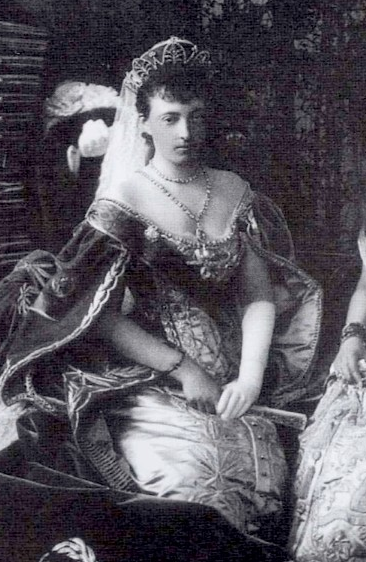 |
| Grand Ladies Site |
Grand Duchess Hilda’s Tiara Stolen
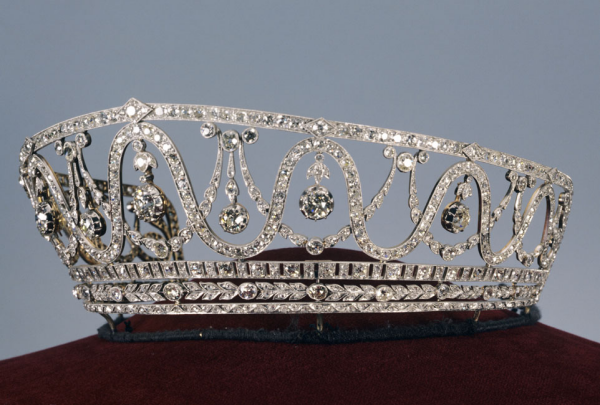 |
| Handout image provided by the Badisches Landesmuseum |
Sad news to report from the jewelry world today: the grand diamond tiara once owned by Grand Duchess Hilda of Baden has been stolen from its home in a Karlsruhe museum.
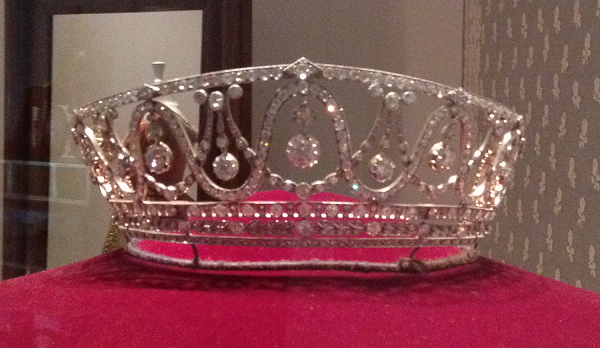 |
| Wikimedia Commons |
The Associated Press reports that the tiara was discovered to be missing from the Badisches Landesmuseum on Saturday, April 29. The tiara was taken from a locked display in the museum’s throne room. (The museum is housed in the former grand ducal palace.) Staff are reportedly perplexed about the methods the thieves used to steal the tiara, as all security measures in the museum were up to international standards. They also aren’t sure if thieves were aiming to steal the piece because of its history or because they simple wanted to remove the diamonds.
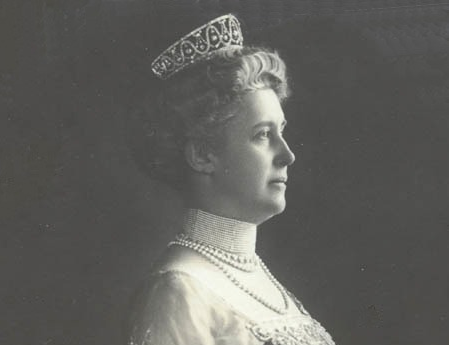 |
| Grand Duchess Hilda (Grand Ladies Site) |
The tiara, which has an estimated value of around $1.31 million, is made of gold and platinum and set with 367 diamonds. It was made for Grand Duchess Hilda, who was born a princess of Nassau, in the early part of the 20th century. The museum names the tiara’s maker as a Baden-based court jeweler, Schmidt-Staub.
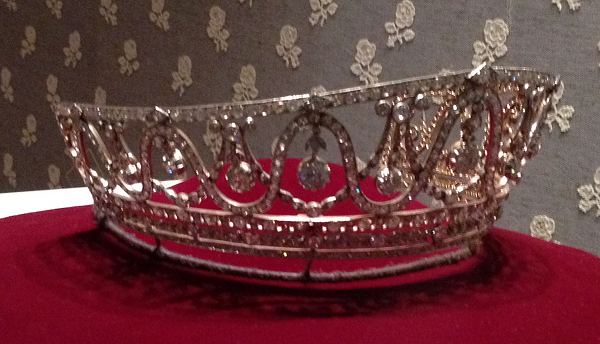 |
| Wikimedia Commons |
The museum’s director, Eckart Köhne, said on Monday: “The diadem is a significant piece of the history of Baden and invaluable to the museum.” The Baden-Wuerttemberg police were informed of the theft shortly after it was discovered, but with no leads, they turned to the public on Monday for help. They are currently seeking anyone with any information about the theft, including possible witnesses to the crime.
Jewel History: Her Majesty’s State Ball (1855)
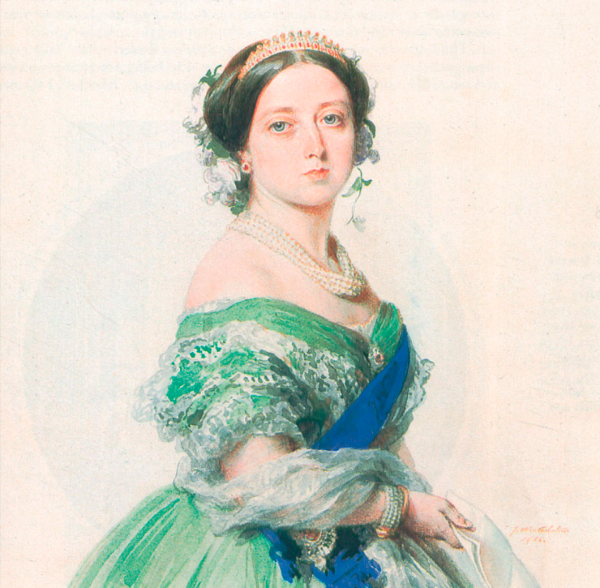 |
| Queen Victoria, painted in watercolors by Winterhalter, ca. 1855 |
The Queen [1], on Wednesday, gave a state ball, to which a party of between 1600 and 1700 were invited, and for which the whole of the state rooms of Buckingham Palace were appropriately and brilliantly illuminated.
The three entrances were arranged as follows: the royal family alighted at the garden entrance; the foreign ministers, privy counsellors, and officers and ladies of the royal household at the Pimlico entrance; and the rest of the company at the grand entrance. The royal family were ushered, on their arrival, to the White Drawing Room. All the other guests assembled in the picture gallery and the promenade gallery, which, for the first time, was opened for a state ball.
The Yeomen of the Guard were on duty on the staircase and in the Grand Hall, under the command of Captain Sir John Kincaid, the Exon in Waiting. A Guard of Honour of the Guards was stationed in front of the palace, with the band of the regiment.
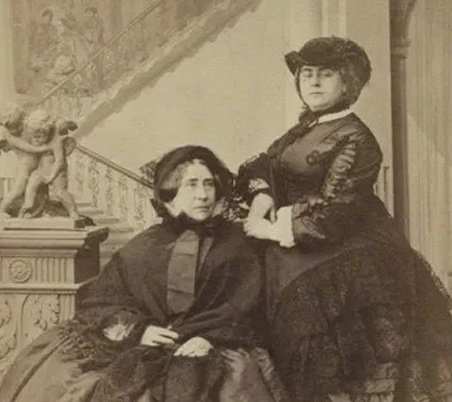 |
| The Duchess of Cambridge and Princess Mary Adelaide of Cambridge, photographed ca. 1860 |
Their Royal Highnesses the Duchess of Cambridge [2] and the Princess Mary [3] arrived at a quarter before ten o’clock, attended by Lady Sutfield and Major Home Purves, and were received by the Maids of Honour and the Grooms and Equerries in Waiting. His Royal Highness the Duke of Cambridge [4] was attended by the Hon. James Macdonald and Colonel Tyrwhitt.
His Royal Highness the Duke of Saxe-Coburg and Gotha [5] was attended by le Conseiller Samwer and Baron de Treskow. His Highness the Maharajah Duleep Singh [6] was also present. Her Majesty and His Royal Highness Prince Albert [7] left the White Drawing Room shortly before ten o’clock, accompanied by Their Royal Highnesses the Duchess of Cambridge, the Princess Mary, the Duke of Cambridge, and the Duke of Saxe-Coburg and Gotha; Their Serene Highnesses the Princess of Hohenlohe-Langenburg [8] and the Princess Adelaide [9] and Prince Victor of Hohenlohe [10].
The Queen wore a dress of pink tulle over pink silk, trimmed with five flounces of white blonde, and ornamented with bouquets of pink roses and white jessamine and diamonds. Her Majesty’s headdress was composed of diamonds and pink roses.
The Duchess of Cambridge wore a dress of grey glace silk, covered with beautiful white Brussels lace to within a short distance of the bottom, which was trimmed with a triple border of white and gray marabout feathers looped up with rosettes of silver crepe. The body was trimmed with Brussels lace to correspond. The stomacher was covered with sapphires and diamonds; the necklace and the tiara were en suite [11]. Her Royal Highness, in addition to the tiara, wore white and gray marabouts in her hair.
The Princess Mary of Cambridge wore a dress of blue tulle over a rich silk glace petticoat, trimmed with bunches of pink roses and tulle. The body was also trimmed with roses. The stomacher was ornamented with diamonds. The necklace, pearls and diamonds. The Princess wore round her head a wreath of pink roses having diamond stars intermixed.
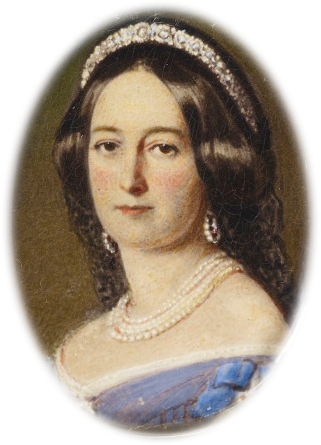 |
| Princess Feodora of Hohenlohe-Langenburg, ca. 1855 |
The Princess of Hohenlohe-Langenburg wore a dress of white satin, trimmed with riband. The necklace, diamonds. Her Serene Highness’s headdress was formed of a garland of flowers and diamond ornaments. The Princess Adelaide of Hohenlohe wore a pink satin dress, trimmed with pink tulle and flowers. Her Serene Highness wore a garland of flowers to correspond with the dress.
The Marquis of Breadalbane, K.T., Lord Chamberlain; Earl Spencer, K.G., Lord Steward; Lord Ernest Bruce, Vice-Chamberlain; and the Earl of Mulgrave, Treasurer of the Household, conducted Her Majesty and the Prince to the ballroom, the Ladies and Gentlemen in Waiting, and afterwards the general company, following the royal circle. A quadrille was formed, and the Queen opened the ball with the Duke of Saxe-Coburg and Gotha at ten o’clock.
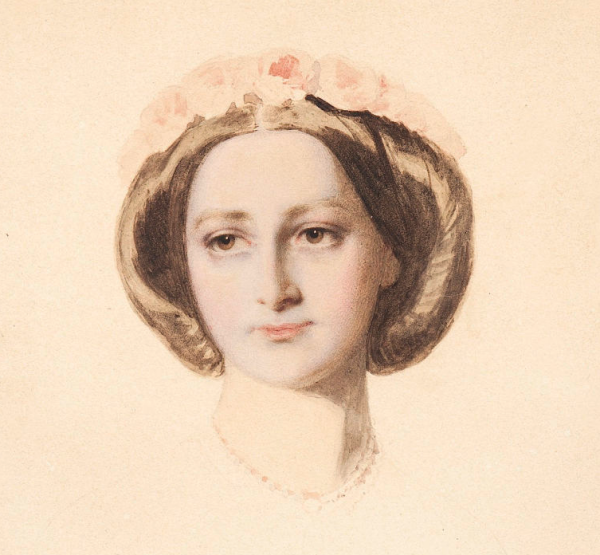 |
| Princess Adelaide of Hohenlohe-Langenburg, ca. mid 19th century |
The quadrille bands in the ballroom and the throne room played a selection of the newest and most fashionable dance music during the evening. In the intervals of the dancing the company retired for refreshment to the Green Drawing Room, and also to the new promenade gallery. This gallery has an arched glass ceiling, spanning the whole width of the apartment, which is divided into seven compartments by ribs of stucco, enriched with architectural ornaments. The glass is ground and ornamented with a very elegant pattern. The mode of illumination is by external lights of Cannel gas; the rays pass through the ceiling and light the gallery in a very novel and effective manner. All the doors leading into the gallery are panelled in looking-glass with very handsome gilt mouldings.
The sculptured white marble chimney-piece was fitted with choice and beautiful plants in flower. This and the picture gallery are connected by a small anteroom, also new, having a miniature dome — the walls, cornice, and ceiling of which are adorned with colours heightened with gilding, producing the utmost richness and variety of effect of which the modern style of decoration is capable. The room was lighted with gilt branches filled with wax lights.
Supper was served on the state service of gold plate. A lofty buffet lined with crimson was erected in the supper room opposite the entrance, on which, among a very numerous selection of rare and beautiful specimens of gold plate, were the magnificent epergne, known as the “Prince of Wales’s Epergne,” and an extremely curious ancient gold dish, of large size and oblong form, from America, and called the “Mexican Dish.”
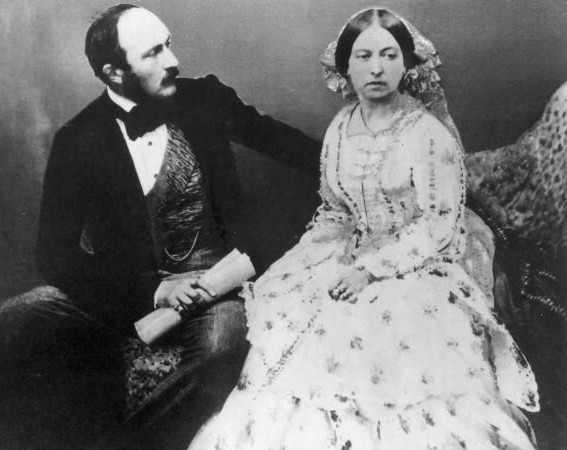 |
| Prince Albert and Queen Victoria, photographed ca. 1854 |
A profusion of roses in full bloom placed in golden vases ornamented the buffet and tables, the whole being brilliantly lit with waxlights in candelabra and sconces of silver gilt.
The invitations were numerous, and the company were very distinguished.
NOTES
1. Queen Victoria of the United Kingdom (1819-1901) was a few weeks shy of her 36th birthday at the time of this state ball. She had been on the throne for nearly eighteen years. She and Prince Albert had been married for more than a decade, and they had eight children. The last, Princess Beatrice, would be born two years later. Shortly after this ball, Victoria and Albert embarked on their famous 1855 state visit to France.
2. Princess Augusta, Duchess of Cambridge (1797-1889), born Princess Augusta of Hesse-Kassel, was Queen Victoria’s aunt by marriage. She was 57 years old at the time of this state ball. Her husband, Prince Adolphus, Duke of Cambridge (the seventh son of King George III) had been dead for almost five years.
3. Princess Mary Adelaide of Cambridge (1833-1897) was Queen Victoria’s first cousin. Twenty-one at the time of this ball, she was the youngest child of Prince Adolphus, Duke of Cambridge and Princess Augusta of Hesse-Kassel. Eleven years later, she married Prince Francis of Teck; they were the parents of Queen Mary.
4. Prince George, Duke of Cambridge (1819-1904) was Queen Victoria’s first cousin. He was the eldest son of Prince Adolphus, Duke of Cambridge and Princess Augusta of Hesse-Kassel, and he had succeeded to the Cambridge dukedom on his father’s death nearly five years earlier. At the time of this state ball, he was 36 years old, almost the exact contemporary of the Queen. In 1847, George had violated the Royal Marriages Act by marrying an actress, Sarah Fairbrother, without seeking the Queen’s permission. George and Sarah already had three sons together, all of whom became military officers: Colonel George FitzGeorge, Rear Admiral Sir Adolphus FitzGeorge, and Colonel Sir Augustus FitzGeorge. By 1855, the Duke had an illegal wife, three illegitimate children, and a mistress, Louisa Beauclerk.
5. Prince Ernst, Duke of Saxe-Coburg and Gotha (1818-1893) was Queen Victoria’s brother-in-law and first cousin. He was the elder son of Prince Ernst, Duke of Saxe-Coburg and Gotha and Princess Louise of Saxe-Gotha-Altenburg; his younger brother, Prince Albert, married Victoria in 1840. Ernst and Albert’s father was the brother of Victoria’s mother, Victoire. The younger Ernst had inherited the Saxe-Coburg and Gotha dukedom on his father’s death in 1844. By the time of this state ball, he was 36 years old and had been the Duke for eleven years. In 1842, he had married Princess Alexandrine of Baden; she appears not to have accompanied him to this ball. Their marriage was childless, probably because of venereal diseases contracted by Ernst before their wedding, and Ernst was not a faithful husband.
6. Maharajah Duleep Singh (1838-1893) was the last ruler of the Sikh Empire. He was sent into exile in England in 1854, and he was only 16 when he attended this state ball a few months later. Queen Victoria and Prince Albert doted on him, even staying with the royal family at Osborne House on the Isle of Wight. He was painted shortly after his arrival by Winterhalter, whose portraits of the British royal family were famous. Not long after this ball, he took a tour of the European continent, settling afterward for a time in Scotland.
7. Prince Albert of the United Kingdom (1819-1861), born Prince Albert of Saxe-Coburg and Gotha, was Queen Victoria’s husband. He was 35 years old in May of 1855. The couple had been married for fifteen years at the time of this court ball, and eight of their nine children had already been born. Two years later, Victoria would give him the title of Prince Consort; in December 1861, he died, sending Victoria and her court into mourning for decades.
8. Princess Feodora of Hohenlohe-Langenburg (1807-1872), born Princess Feodora of Leiningen, was the elder half-sister of Queen Victoria. She was 47 at the time of this ball. She had been married to Prince Ernst of Hohenlohe-Langenburg since 1828, but although she left Britain for Germany when Victoria was only ten, the sisters had a close relationship. Feodora visited Britain often, bringing her children with her. At the time of this ball, all of her surviving children were unmarried; her second child, Princess Elise, had died five years earlier.
9. Princess Adelaide of Hohenlohe-Langenburg (1835-1900) was the fifth child of Princess Feodora and, therefore, a niece of Queen Victoria. She was 19 years old at the time of this state ball. Three years earlier, she had caused a minor family crisis when Napoleon III, who had just become Emperor of France, asked for her hand in marriage. Queen Victoria and Prince Albert were displeased by the idea of their niece being used to shore up the legitimacy of the shaky French throne, and Adelaide’s parents declined the offer. In 1856, Adelaide married Duke Friedrich VIII of Schleswig-Holstein; one of their daughters, Princess Augusta Viktoria, would eventually marry one of Victoria and Albert’s grandsons, Kaiser Wilhelm II of Germany.
10. Prince Victor of Hohenlohe-Langenburg (1833-1891) was the fourth child of Princess Feodora and, therefore, Queen Victoria’s nephew. He was 21 years old at the time of this state ball. Although he was born and raised in Germany, Victor made his life in Britain. He had joined the Royal Navy in 1848, and at the time of this ball, he had recently been promoted to lieutenant. Six years later, he married an Englishwoman, Laura Seymour, who was given the title of Countess von Gleichen by Victor’s cousin (and Prince Albert’s elder brother), the Duke of Saxe-Coburg and Gotha.
11. These are the famous Cambridge sapphires, which were later inherited by the Duchess’s granddaughter, Queen Mary. Princess Marina, Duchess of Kent received the sapphires from Queen Mary as a wedding present; her descendants have sold off some pieces of the set, including the original tiara, but they still own some of the sapphires today.
- « Previous Page
- 1
- …
- 83
- 84
- 85
- 86
- 87
- …
- 151
- Next Page »